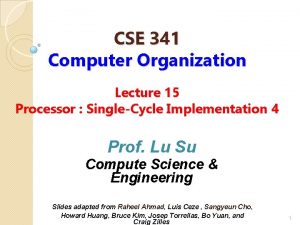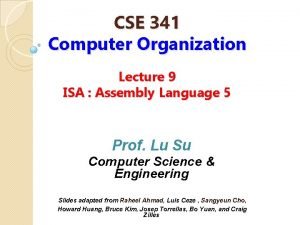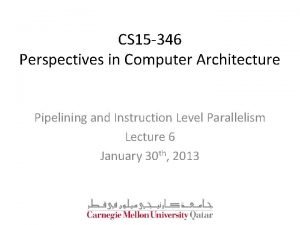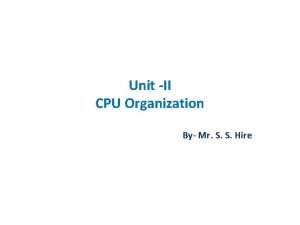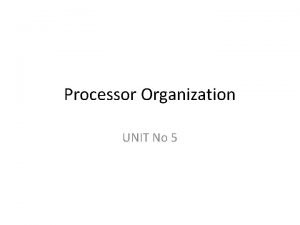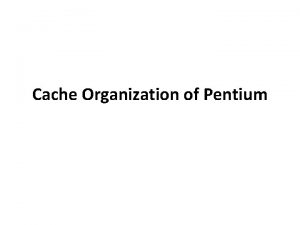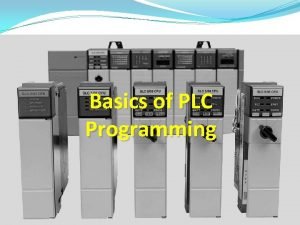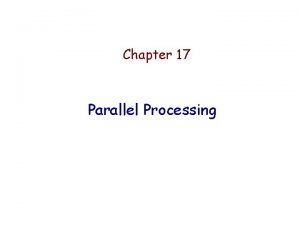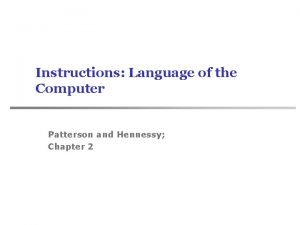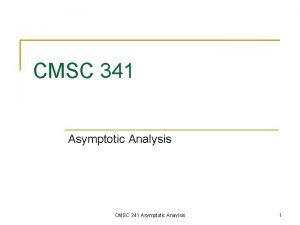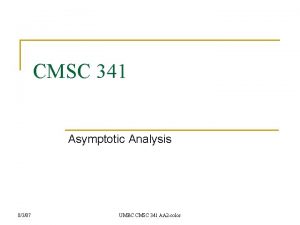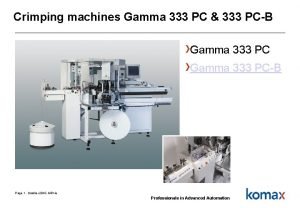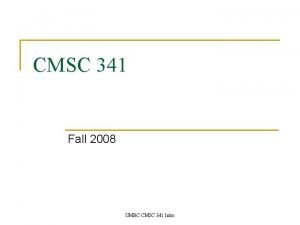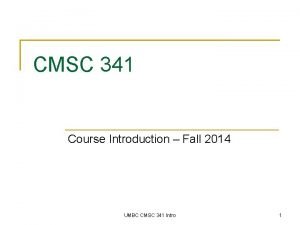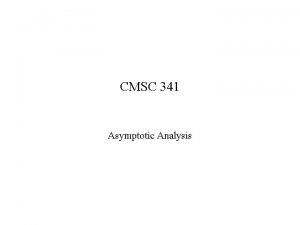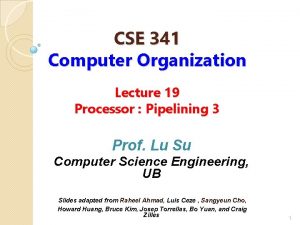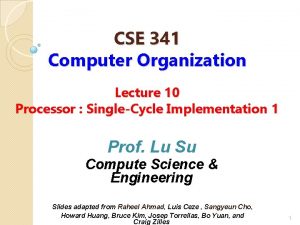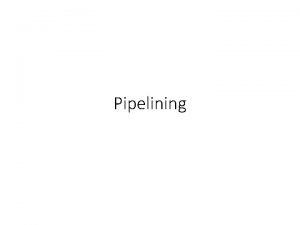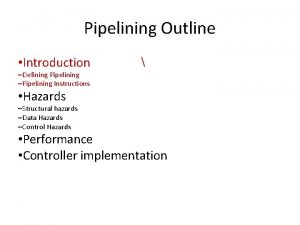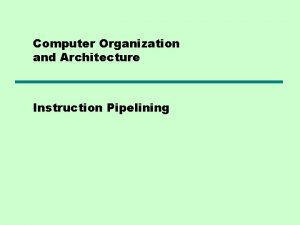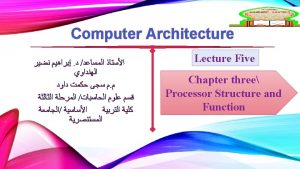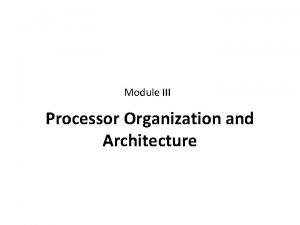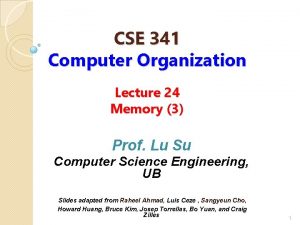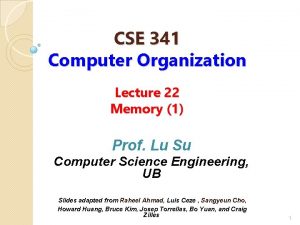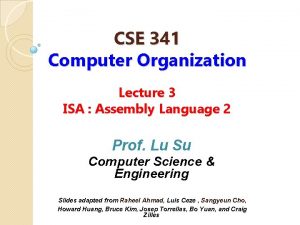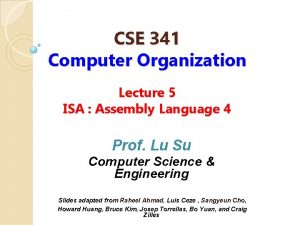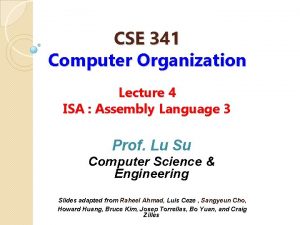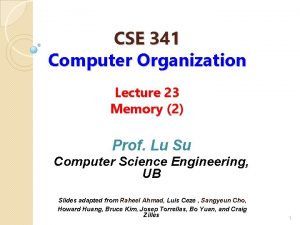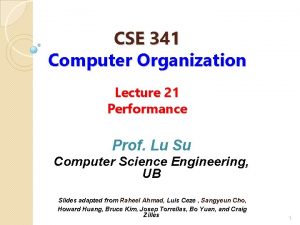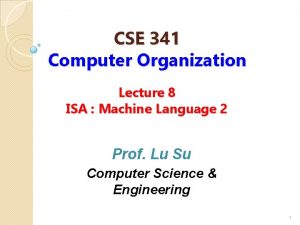CSE 341 Computer Organization Lecture 18 Processor Pipelining































- Slides: 31

CSE 341 Computer Organization Lecture 18 Processor : Pipelining 2 Prof. Lu Su Computer Science Engineering, UB Slides adapted from Raheel Ahmad, Luis Ceze , Sangyeun Cho, Howard Huang, Bruce Kim, Josep Torrellas, Bo Yuan, and Craig Zilles 1

Task III l Single-cycle implementation: -- All operations takes in one clock cycle l Multi-cycle implementation: -- Fast operations take less time than slower ones l Pipelining -- Overlap the execution of several instructions 2

5 -Stage Pipeline IF ID EXE WB MEM Reg. Write Read Instruction address [31 -0] Mem. Write I [25 - 21] Read register 1 I [20 - 16] Instruction memory 0 M u I [15 - 11] x 1 Read data 2 Write register Write data Registers 0 M u x 1 Result ALUOp I [15 - 0] Read address Read data 1 Data memory 0 Write address Write data M u x Mem. Read ALUSrc Reg. Dst 2 ns ALU Zero Read register 2 Mem. To. Reg Sign extend 2 ns 2 ns 3

Pipelining Loads lw lw lw $t 0, $t 1, $t 2, $t 3, $t 4, 4($sp) 8($sp) 12($sp) 16($sp) 20($sp) 1 IF 2 ID IF 3 EX ID IF 6 PM 7 Clock cycle 4 5 6 MEM WB EX MEM WB ID EX MEM IF ID EX IF ID 8 7 8 9 WB MEM EX WB MEM WB 9 Time 30 40 40 20 4

Pipeline Diagram Pipeline diagram shows the execution of a series of instructions. -- Instruction sequence is shown vertically (top to bottom) -- Clock cycles are shown horizontally (left to right) -- Each instruction is divided into its component stages. Clock cycle l Overlapping is 5 shown in 7 the 8 diagram. 1 2 of instructions 3 4 6 9 l lw sub and or add $t 0, 4($sp) $v 0, $a 1 $t 1, $t 2, $t 3 $s 0, $s 1, $s 2 $sp, -4 IF ID IF EX ID IF MEM EX ID IF WB MEM EX ID WB MEM EX WB MEM WB 5

Some Terminology The pipeline depth is the number of stages: 5 in this case l In the first 4 cycles here, the pipeline is filling, since there are idle functional units. l In cycle 5, the pipeline is full. Five instructions are being executed simultaneously, no idle functional units. Clock cycle 3 4 is emptying. 5 6 7 8 9 l In cycles 16 -9, 2 the pipeline l lw sub and or add $t 0, 4($sp) $v 0, $a 1 $t 1, $t 2, $t 3 $s 0, $s 1, $s 2 $sp, -4 IF ID IF EX ID IF filling MEM EX ID IF WB MEM EX ID IF full WB MEM EX ID WB MEM EX WB MEM emptying WB 6

Single vs Multiple vs Pipelining 7

Pipelining Performance l Execution time on ideal pipeline: --Time to fill the pipeline + one cycle per instruction --What is the execution time for N instructions? l Compare with other implementations: -- eg. Single Cycle with 8 ns clock period ? l How much faster is pipelining for N=1000 ? 8

Pipelining other instruction types l For other types of instructions, eg. R-type instructions, it only require 4 stages: IF, ID, EX, and WB -- MEM stage is not needed. l Some problems when we try to pipeline loads with R-type instructions… add sub lw or lw $sp, -4 $v 0, $a 1 $t 0, 4($sp) $s 0, $s 1, $s 2 $t 1, 8($sp) 1 IF 2 ID IF 3 EX ID IF Clock cycle 4 5 6 WB EX WB ID EX MEM IF ID EX IF ID 7 8 9 WB WB EX MEM WB 9

A solution: Insert NOP stages l Enforce uniformity -- Make all instructions take 5 cycles with the same stages in the same order -- Some stages will do nothing for some R-type IF ID EX NOP WB instructions add sub lw or lw $sp, -4 $v 0, $a 1 $t 0, 4($sp) $s 0, $s 1, $s 2 $t 1, 8($sp) 1 IF 2 ID IF 3 EX ID IF Clock cycle 4 5 6 NOP WB EX NOP WB ID EX MEM IF ID EX IF ID store IF ID EX MEM NOP branch IF ID EX NOP 7 8 9 WB NOP EX WB MEM WB 10

Review of Pipelining l Pipelined processor allows multiple instructions to execute simultaneously. Each instruction uses a different functional unit in the datapath. �Increased throughput and faster program -- Simpler stages also lead to shorter cycle times. lw sub and or add $t 0, 4($sp) $v 0, $a 1 $t 1, $t 2, $t 3 $s 0, $s 1, $s 2 $t 5, $t 6, $0 1 IF 2 ID IF 3 EX ID IF Clock cycle 4 5 6 MEM WB EX MEM WB ID EX MEM IF ID EX IF ID 7 8 9 WB MEM EX WB MEM WB 11

Datapath in Pipelining The key idea of pipelining is to allow multiple instructions to execute at the same time. l So several operations are needed to be performed in the same cycle. -- Increment the PC and add registers -- Fetch one instruction and access data memory l Similar to single-cycle datapath, datapath of pipelined processor need duplicate hardware units l lw sub and or add $t 0, 4($sp) $v 0, $a 1 $t 1, $t 2, $t 3 $s 0, $s 1, $s 2 $t 5, $t 6, $0 1 IF 2 ID IF 3 EX ID IF Clock cycle 4 5 6 MEM WB EX MEM WB ID EX MEM IF ID EX IF ID 7 8 9 WB MEM EX WB MEM WB 12

One register file is enough l Only one register file is enough to support both the ID and WB stages. -- Reads and writes go to separate ports on the register file. -- Writes occur in the first half of the cycle, reads occur in the second half. Read register 1 Read data 1 Read register 2 Read data 2 Write register Write data Registers 13

Review of Single-cycle Datapath (slightly rearranged) 14

Recall of Intermediate registers in Multi-Cycle Design l Some outputs of a functional unit in multi-cycle design need to be used in later cycle, for example: -- The instruction word fetched in stage 1 determines the destination of the register write in stage 5 These outputs need to be stored in intermediate registers -- Save the instruction read in stage 1 in Instruction register -- Save Register file outputs from stage 2 in registers A and B -- Save the ALU output in register ALUOut -- Save the data fetched from memory in stage 4 in the l

The Final Multi-cycle Datapath PCWrite PC ALUSrc. A Ior. D Reg. Dst 0 M u x 1 0 Reg. Write Mem. Read Address Memory Write Mem data Data Mem. Write IRWrite 0 M u x [31 -26] [25 -21] [20 -16] [15 -11] [15 -0] Instruction register Memory data register 1 Read register 1 data 1 A Read register 2 B Write register Read data 2 4 Write Registers data 1 Mem. To. Reg 1 Sign extend Shift left 2 0 ALU Zero Result 0 1 2 3 ALUSrc. B 0 M u x ALU Out M u x 1 PCSource ALUOp

Pipeline Registers l Intermediate registers are needed to guarantee functional validity. -- Drawing one big pipeline register between each stage to simplify drawing. l The registers are named for the stages they connect. -- IF/ID ID/EX EX/MEM MEM/WB l No register is needed after the WB stage since at that time the instruction has been done. 17

Pipelined datapath 18

Pipelining l Similarly to datapath, some control signals must be propagated through the pipeline until they reach the appropriate stage. --Just pass them in the pipeline registers, along with the other data. l Control signals can be categorized by the pipeline stage that uses them. 19

Pipelined Datapath and Control 20

Example l An example �Some assumptions: -- Each register contains its number plus 100. For instance, register $8 contains 108 -- Every data memory location contains 99. �Our pipeline diagrams will follow some conventions. -- X indicates values that aren’t important 21

Cycle 1 (filling) 22

Cycle 2 23

Cycle 3 24

Cycle 4 25

Cycle 5 26

Cycle 6 27

Cycle 7 28

Cycle 8 29

Cycle 9 30

Some Conclusions Using the prior pipeline, up to five instructions can be executed simultaneously. -- Implies that the maximum speedup is 5 times. -- In general, the ideal speedup equals the pipeline depth. l Pipelining does not improve the execution time of any single instruction. l Some times pipeline even makes instruction actually takes longer to execute than in a singlecycle datapath l Instead, pipelining increases the throughput, or the amount of work done per unit time. Here, several instructions are executed together in each clock cycle. 31 l
 Jump instruction
Jump instruction Cse 341
Cse 341 Organisasi komputer
Organisasi komputer Non linear pipeline
Non linear pipeline Pipelining in computer architecture examples
Pipelining in computer architecture examples Process organization in computer organization
Process organization in computer organization 01:640:244 lecture notes - lecture 15: plat, idah, farad
01:640:244 lecture notes - lecture 15: plat, idah, farad Processor organization
Processor organization Data flow, fetch cycle
Data flow, fetch cycle The pentium has kb instruction and kb data cache
The pentium has kb instruction and kb data cache Memory cycle of plc
Memory cycle of plc Processor organization
Processor organization Processor organization
Processor organization Basic structure of a computer system
Basic structure of a computer system Difference between architecture and organization
Difference between architecture and organization Complete computer description in computer organization
Complete computer description in computer organization Register in computer organization
Register in computer organization Sda hymn 341
Sda hymn 341 Ecma-341
Ecma-341 Cmsc 341
Cmsc 341 Umbc cmsc 341
Umbc cmsc 341 Round 716 to the nearest hundred
Round 716 to the nearest hundred Komax ims 295
Komax ims 295 Cmsc 341
Cmsc 341 Cmsc 341 umbc
Cmsc 341 umbc Umbc cmsc 341
Umbc cmsc 341 Cmsc 341
Cmsc 341 341 ces
341 ces Cmsc 341
Cmsc 341 Acer xr
Acer xr Oh mon sauveur a toi seul je veux etre
Oh mon sauveur a toi seul je veux etre Mgmt 341
Mgmt 341
